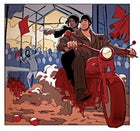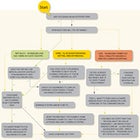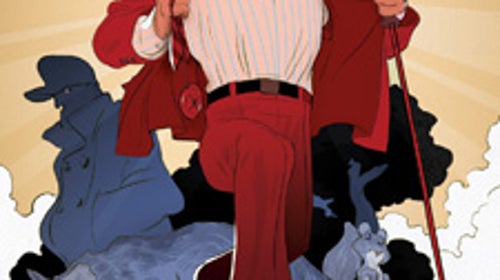NAIL THE LANDING
�����ԹϺ��� Guide
 A graduate-level, four-part seminar to help you master the art of adventure in every facet of your life.
A graduate-level, four-part seminar to help you master the art of adventure in every facet of your life.The first test on many international adventures takes place before you leave the airport
Just past the customs kiosk, you’ll often find a mob of drivers, porters, and other assorted “helpers.” The right move depends on the context. If you’re heading someplace especially disorienting, like Indonesia or even some parts of Mexico, book your first night’s accommodations from home, then ask the hotel to send a driver to meet you bearing a sign with your name on it. (Hotels used to catering to Westerners, and particularily those in developing countries, do this all the time.) It might cost a bit more, but it’s worth it. “While it sounds very bourgeois,” says Robert Young Pelton, author of The World’s Most Dangerous Places, “it won’t be any more expensive than a normal taxi.”
If you’ve landed someplace mellower, like the Philippines or Kenya, and now you’ve got a scrum of young men buzzing around your huge pile of gear, the first thing you need to do is slow down and shop around. Trust your instincts and be wary of the most aggressive hawkers; you want the confident guy hanging back. Then hire someone. “Don’t be the Westerner who’s so afraid of being ripped off that he refuses to spend any money or who believes in the dogma of self-sufficiency,” says author and filmmaker Sebastian Junger. “You’ll just look like a jerk.”
Never Get Caught Empty-Pocketed
Being prepared means being able to survive with what's in your pants.
This past September, Stuart Nelson Jr., the Iditarod’s chief veterinarian and an experienced outdoorsman, capsized his kayak on a solo paddling trip in the Yukon. From the water, he watched as his boat—and food, shelter, and satellite phone—rushed irretrievably downstream. For 13 days, he survived on the contents of his pockets, which, because Nelson knows what he’s doing, were a veritable hardware store: a folding knife, a wire saw, a signal mirror, two lighters, some Sterno (in a tiny Nalgene bottle), a space blanket, tincture of iodine, 30 feet of parachute cord, three silver spinner fishing lures, and some fishing line. This likely won’t happen to you, but the lesson is clear: should you get separated from your pack or boat—or, worse, your guide and the rest of your tripmates—what you’ve got on your person is what you’ve got. At a minimum, according to survival expert Tony Nester, founder of Ancient Pathways (), you should be prepared with what he calls “the big four”: a spark rod or waterproof matches (not a lighter, which is useless when wet) to make a fire, iodine tablets to purify water, a glass mirror or whistle to signal help (this is especially important if you can’t move), and, to build a temporary shelter, a pocket-size heat sheet or space blanket.
Follow the Rules
Consider these basic tenets of far-flung exploration
SLOW DOWN. We peppered our experts with dozens and dozens of questions—What if your local guide tries to shake you down? How do you convince a midlevel bureaucrat in Haiti to give you a permit?—and the answer was often a variation of one main theme: Be patient, and don’t try to force it.
MIND THE ELDERS. Every culture has its idiosyncrasies, but this is a constant. “Always be extremely respectful of older people, especially in rural cultures,” says Junger. “All the knowledge is with the elderly. It’s their Google.”
MAKE CONNECTIONS. “You want to make friends,” says Pelton. “When you travel you need to make friends. Carry some sort of gift, like cheap pens with your name and e-mail address on it.” The reverse is also true: “Always ask people you befriend for their phone numbers,” says �����ԹϺ��� contributing editor Patrick Symmes. “Then, if you get into a jam, you’ve got a local contact.”
Pack Like a Pro
Is it a business trip with a bit of adventure on the side or a two-week dream vacation? It doesn’t matter much: you're taking too much. The following tips should help lighten your load.
�����ԹϺ��� Guide
 Remember to pack only what you need.
Remember to pack only what you need.SMARTER SHIRTS AND SHOES SAVE SPACE. If you need to keep up appearances, get a quick-drying CoolMax cotton/poly dress shirt like Dunning’s Slim Fit Performance Woven Gingham ($98; ). It wicks like a base layer but passes muster at the white-tablecloth restaurant. And instead of packing both sandals and light hikers, split the difference with a versatile water shoe like Olukai’s Kia‘i Trainers ($100; ). They drain and dry quickly and are plenty sturdy for day hikes but look normal—nay, sharp—with khakis.
STILL CAN’T FIT IT ALL IN YOUR BAG? We used to make fun of our anal friend’s packing cubes. Then we field-tested Flight 001’s F1 SpacePaks (from $30; ). Each has separate clean and dirty compartments, and, thanks to one-way vents, you can compress all the air out of your neatly folded clothing. Upshot: we were able to cram in approximately a third more stuff—and didn’t have to pack a larger (and heavier) bag.
POWER, PACKED. For iPods and cell phones, our go-to portable charger is PowerMonkey’s eXplorer ($103; ). It can store several charges’ worth of juice at a time, has a battery meter to let you know how much mojo you’ve got left, and recharges via the wall (in 150 countries) or the sun. For all your other devices—avalanche transceiver, headlamp, two-way radio, GPS, digital camera, etc.—follow this simple rule: the more remote the destination, the more of your gadgets should run on easy-to-find AA or AAA batteries. (Try to find a CR123 in rural Turkey.) If you have some of each kind of device, buy reusable adapters for a few bucks that turn AAAs into AAs ().
Pull Off a Big Trip
You're not getting any younger, and it only gets harder.
Professional ski-mountaineer and guide Chris Davenport has organized dozens of expeditions on every continent. Here’s what he’s found: it doesn’t matter if what you’re planning is relatively simple (backcountry hut trip, reunion in Costa Rica) or complex (remote paddling trip in Alaska); it’s all about organization.
ESTABLISH A GROUP LEADER. Usually it’s the guy who came up with the idea; he wants to do the trip the most. When there’s a leader, all the others know what time they need to wake up and where they need to be.
CHOOSE YOUR TEAM WISELY. When it comes to any outing that’s based on a sport, the group is only as fast as its slowest member.
DEMAND COMMITMENT. Start by establishing a cutoff date. If your trip is in April, people have to buy plane tickets by January or they’re out. For a hut trip to a place that sleeps 12, I’ll send out 20 invites. The first 12 to commit are the ones who are going.
KNOW YOUR GEAR. A once-in-a-lifetime adventure isn’t the time to try out brand-new—or rent unfamiliar—equipment.
MAKE LISTS. Lots of lists.
Get Paid for It
The bigger you go, the more likely someone else will pick up the tab.
Expedition funding isn’t just for elite professional athletes and scientists. With the right idea and a convincing proposal, anybody can get a trip funded. “You have to answer the so-what question,” says Jeff Blumenfeld, editor of . “Sponsors respond to projects that are different—that seem to be more than a vacation.” Sweeten the deal by promising as much media exposure as you can handle: the more blogs, magazine articles, videos, Facebook posts, and pictures you can provide, the better. Blumenfeld cites Andre Tolme, the man who in 2003 and 2004 golfed his way in 12,170 strokes across Mongolia, as a prime example of creativity trumping athletic prowess. “It also helps to solve a mystery or find something,” adds Blumenfeld. “Like Irvine’s camera, Amundsen’s tent, or Amelia Earhart.” His guide to expeditions, You Want to Go Where? ($25; Skyhorse), is packed with hundreds of tips, including info on more than a dozen grants, but the following big three are a good place to start.
GORE-TEX SHIPTON/TILMAN GRANT: Probably your best shot, given it’s for “avid enthusiasts who believe in traveling in small, compact teams, unburdened by porters and excessive bulk.” Three to six expeditions divvy up $30,000;
POLARTEC CHALLENGE GRANT: The most “compelling, passionate, and original adventures” in any sport undertaken by “frugal, low-impact teams who respect the local culture.” That’s totally you. Two to four expeditions divvy up $10,000-$15,000;
THE ROYAL GEOGRAPHICAL SOCIETY’S JOURNEY OF A LIFETIME: Creativity and salesmanship will net you funding for “an original and inspiring journey anywhere in the world, awarded to those with a curiosity about the world and the desire to communicate with a wider audience.” One winner at $6,300;
Look the Part
If you're venturing to an unstable or potentially dangerous country, you'll want to pay closer attention to your wardrobe.
Blending In
 Look the part
Look the partSome things are obvious: wear bland, low-key clothing, avoid expensive watches, and don’t flaunt your gadgets. Others things, less so: if you have to load your fancy-looking luggage into the cargo hold—or, worse, throw it on top of the bus with the chickens—cover it with the same grain sacks/burlap bags the locals use. The trick is to mimic without mocking. Wearing a Yankees hat in Cuba (where they’re everywhere) or an Adidas tracksuit in Venezuela (ditto)? Good move. Sashaying around Islamabad in a traditional shalwar kameez? Probably not. Just don’t forget: manners always speak louder than garb.
“If you buy an Afghan scarf and act like an asshole,” says Junger, “you’re still an asshole.”
Kill Like a Caveman
Sometimes hunting like Fred Flintstone is the only option, according to Steven Rinella, star of the Travel Channel show “The Wild Within.”
Hunting with rocks.
 Sometimes hunting like Fred Flintstone is your only option.
Sometimes hunting like Fred Flintstone is your only option.Let’s say you’re in a serious pickle—out there, lost, hungry—and need protein. Your best bet, according to contributing editor Steven Rinella, star of the new Travel Channel show The Wild Within, is to take aim at small game like a squirrel, grouse, or rabbit—and keep it simple:
“The bottom line is you shouldn’t take any tool you don’t already know how to use, or think you’re going to save your ass by attempting some technique you’ve never done. A slingshot They’re a joke, a toy … have you ever tried to actually hit a target with one? Impossible. That’s what’s so great about a rock: anybody can huck one. … You’re going to need a bigger one than you think. Generally speaking, you need a rock about the size of the animal you’re trying to kill. It’s essentially a shock-and-awe tactic—you just want to coldcock it. Get as close as you can. Don’t look at it in the eye and don’t walk directly toward it. Take an oblique angle, like you’re going to walk right past it, quickly and assuredly, without noticing it. At the point at which you’re closest to the animal, turn and throw the rock in one fluid motion. The blow may only momentarily stun the animal, so leap on him and finish him off right away.”
Get Fixed
Because when the going gets tough, the tough… hire help.
It doesn’t matter if your objective is safeguarded by red tape (isolated Nepalese village) or the Mob (that underground Russian nightclub you read about online), there are simply some places you won’t make it alone. Fixers are a globe-trotting journalist’s secret weapon. Translators, drivers, navigators, skid greasers— they’re just as happy to work for you as for a deadline-driven reporter. The best ones, according Scott Anderson, who has reported from places like Lebanon, Darfur, and Chechnya, have “a scoundrel’s personality”—i.e. they enjoy gaming the system, which is exactly what you need for everything from negotiating tricky border crossings to locating obscure trailheads. Start searching for your fixer before you go by posting queries on travel sites like , , or Robert Young Pelton’s site, . Once on the ground, try a bus station, coffee shop, hotel, or bar where travelers and expats hang out. You want a local. “Look for someone cocky who isn’t in a hurry to lower their price,” says Anderson. “That shows competence.” Expect to pay $20 a day someplace like India, but up to $200 a day in Afghanistan.
Hustle the Hustlers
Sometimes a bribe is the right call. Usually it's not.
If the situation is life-threatening, like a drunk soldier demanding a few bucks at a remote African checkpoint, pay up and get out of there. But if it feels like you’re getting scammed, you probably are—and whether or not you pay will depend on your patience and the amount. “If it’s under five dollars, I don’t have a problem doing so,” says Pelton. “It’s basically a tip.” If it’s more than that, most adventure and travel experts we spoke with advised the same thing: Be frustrating. “Never speak the local language and don’t even speak English,” says Pelton. “Just speak gibberish—literally gibberish—and pretend not to understand.” Play dumb tourist enjoying a cultural experience. Eventually, the official or officer will get sick of you and leave. Not working? Don’t admit that you did anything wrong, ask for a receipt for the fine, and never hand over your original driver’s license or passport—bring along laminated color photocopies.
Always Leave ‘Em Laughing
Travel writer and humorist Chuck Thompson on how to tickle anyone's funny bone.
“This American idea of a joke, with a setup and punch line, doesn’t translate across cultures. There’s no tradition of ‘Two guys walk into bar …’ in Africa, so a joke isn’t going to help you. But one thing that is universal is food. People like to stick their most outrageous dish in front of you. They want you to cringe at some disgusting pile of kitten ovaries stewed in sheep’s urine—and your unpleasant face always gets a laugh. Another surefire tactic is to learn one or two dirty phrases, because no matter how much you practice, it’s going to sound like some idiot foreign accent. It’s the Yakov Smirnoff effect. Just learn to say penis or twat or fucking like a fiddler’s elbow in whatever the local dialect is and you’ll have them rolling.”
Essential �����ԹϺ��� Moves
Moves you should know on the snow, in the water, and around the urban jungle.
Whitewater Grab
PREDICAMENT: Your buddy is upside down and unconscious in a kayak.
GUT REACTION: Jump out of your boat and yank him to the surface.
ON SECOND THOUGHT: Flip him upright using what’s known as the Hand of God rescue. “You’re both safer inside your boats,” says pro kayaker Brad Ludden. It’ll be easier for you to float (versus swim) him to shore, and your buddy will remain protected from rocks. Here’s how you do it: (1) Pull parallel to the victim’s kayak. (2) Drop your paddle, reach across the overturned kayak, and grab the cockpit rim—clamp down right through the neoprene spray skirt. (3) Push down hard with your other hand on the near edge of the overturned kayak and haul the far cockpit rim toward you. “Throw your entire body into it,” says Ludden. (4) The boat, with your friend inside, will roll up surprisingly easily.
Concrete Jungle
PREDICAMENT: You’re being mugged.
GUT REACTION: Hand over your wallet.
ON SECOND THOUGHT: Hand over a decoy wallet instead, filled with expired IDs, credit cards, and some trivial amount of the local currency. �����ԹϺ��� contributing editor Patrick Symmes pulled this move two years ago in Venezuela, forking over the wallet, a wad of expired Bolivian bills, and the $70 in his pocket—preserving the $500 he’d zipped into a money belt.
Avalanche Rescue
PREDICAMENT: You’ve located your buried ski partner with transceiver and probe.
GUT REACTION: Start digging straight down!
ON SECOND THOUGHT: You remember that snow-safety experts have recently devised a smarter strategy and start your excavation downhill of the victim. You’ll save energy and precious seconds (or even minutes) by not lifting the dense debris out of a pit. Plus, because you’re not on top of him, your body weight is less likely to inadvertently collapse his air pocket. “Strategic shoveling is saving lives,” says Bruce Edgerly, owner of Backcountry Access (BCA) and author of the paper “The ABC’s (and D) of Digging,” which focuses on “preserving the airway (A), using burial (B) depth to define the excavation area, clearing (C) snow to the sides first, and digging (D) snow only once.” For more details, including step-by-step instructions, click on the Education and Research tab on BCA’s Web site, .
Essential �����ԹϺ��� Gear
Basic travel gear you shouldn’t leave home without.
A Compass
Your GPS or smartphone might be faster and more informative … until your battery dies or your coverage fades. Even just wandering around a foreign city, it’s nice to know you’ll always have your bearings. Or, as journalist Scott Anderson puts it, “There’s just something cool about carrying a compass.” We like Brunton’s Classic 9020G ($13; ).
Quality Binocs
There’s always something—wildlife, snow/surf/wind conditions, a distant mountain pass—you want to see just a bit closer. (If there isn’t, why are you here?) Cheap models are like cheap flatscreen TVs: what’s the point? The best portable pair: Bushnell Legend Ultra HD 10×42 ($413; ).
A Sturdy Knife
For building a shelter. Skinning an animal. Or simply cutting cheese. It should have a good-size (3.5-inch) partially serrated stainless- steel blade, like the one on Benchmade’s 551S Griptilian ($105; ). “I like to attach it to my belt loop with a bit of parachute cord,” says Junger, “so I never drop it.”
A Trusty Belt
The unanimous favorite here is Bison Designs’ Last Chance Belt (from $16 for the plenty tough “light duty” version; ). “Its aluminum buckle and sliding lock mechanism are designed so it literally can’t come undone,” says Steven Rinella. “I’ve actually used it to rappel. [Editors’ note: not advisable.] It’s kinda cool knowing that you’re rigged for a medevac at all times.”
You Make the Call
Guide of no guide? Bring your dog? Rent or buy? Here’s how to make the right call.
Motorcycle travel.
 “Pay Attention to the rhythm of the local drivers,” says Grant Johnson.
“Pay Attention to the rhythm of the local drivers,” says Grant Johnson.Dog or No Dog?
It happens during the planning of almost every group wilderness outing: somebody will ask if he can bring his dog. The answer depends on the dog and the owner—your call there—but also the activity. Before you ask, make sure your pooch has the requisite training. —GRAYSON SCHAFFER
CANOEING/RAFTING: Your dog should be able to board and exit the boat calmly and lie quietly while you’re floating. If you’ll be running serious rapids—only in a raft, please—get him a life jacket with a sturdy haul loop, like Ruff Wear’s Big Eddy Float Coat ($75; ).
SKIING: Having your dog pull you on your nordic skis with a mushing harness ($65; ) is a great idea. But backcountry skis, with their razor-sharp edges, can slice a dog’s tendon instantly. Unless Rexwill heel a safe distance from skiers and wait up top while you ski down, don’t bring him. If he’s well behaved enough, protect his paws with Ruff Wear’s new Bark’n Boots Polar Trex ($90; ).
HIKING/CAMPING: If you’re OK seeing less wildlife, then OK. When you’re in camp, dogs should be on their beds (like Mud River’s roll-up Cache Cushion, $30; ) and not cruising for scraps or playing grab-ass with each other. Have them carry up to 15 percent of their weight with Ruff Wear’s Palisades Pack ($125; ).
MOUNTAIN BIKING: Don’t do it. Your dog might love it, but it’s a recipe for arthritis. Exception: it’s fine to exercise hard-running breeds like pointers, heelers, and huskies beside the bike, but if you’re riding for your own fitness, especially downhill, leave him at home.
Write Your Own Motorcycle Diary
We all share the same dream: to self-sufficiently tour some remote mountain range or far-flung country by motorbike. Grant Johnson, owner of , a respected Web site on international motorcycle travel, is here to help you make it a reality.
RENT OR BUY? “If you’re going for less than a month, rent,” says Johnson. “It might cost you more than a car up front, but you’ll spend way less on gas.” But if you’ve taken off six weeks or more (you bastard), consider buying. The HUBB section of Johnson’s Web site has user-generated suggestions for both options in nearly every country on earth. If you buy, spend at least $1,000, then put $100 in upgrades and maintenance into the bike before you set off; you’ll likely recoup all of that when it’s time to sell. Either way, ride local—so parts and knowledgeable mechanics are easy to come by. In Bolivia, that means the Yamaha 125cc trail bike; in India, get the Royal Enfield.
BRING THE BRAIN BUCKET. The motorcycle shop you rent or buy from can help you with paperwork and insurance, but don’t count on finding a helmet that fits. Bring yours from home, along with some warm-weather body armor. Just because the locals forgo helmets—and often prefer shorts and flip-flops—doesn’t mean you should.
FOLLOW THE LEADERS. “Pay attention to the rhythm of the local drivers,” says Johnson. “In Mexico City, if a gap opens and you don’t shoot through, you’ll get hit by the rider behind you, who will. You have to ride the way they expect you to.” If in doubt, Johnson says, pull over and watch the traffic until the customs become apparent.
Medic!
Do yourself and your tripmates a favor and get some training. A weekend class is fine; a 70-to-80-hour Wilderness First Responder course ($450–$900) from Wilderness Medical Institute (nols.edu/wmi), SOLO (), or Wilderness Medical Associates () is better. In the meantime, Dr. Luanne Freer addresses a few potentially confounding predicaments.
SITUATION: Your buddy rings his bell hard at the ski resort. He never went unconscious but was woozy for a bit and is shaken but OK now.
FIRST RESPONSE: Don’t let him take a breather in the lodge; call ski patrol immediately.
PROBLEM: He might have epidural hematoma (bleeding in the skull), which is treatable if diagnosed right away. (This is what killed Natasha Richardson.)
FREER’S RX: Ski patrol will check for any neurological trouble. If they release him, “monitor for 24 to 72 hours, avoiding strenuous activity but eating and drinking normally.” If he continues to feel dizzy or sick, take him to a doctor.
SITUATION: Your leg is punctured by a stingray.
FIRST RESPONSE: Open the first-aid kit.
PROBLEM: Pain; infection if barbs break off in the wound.
FREER’S RX: “Clean the wound and make sure none of the barbs broke off and remain embedded. Soak the wound in warm water to neutralize the venom. Monitor for infection.” And, no, you shouldn’t pee on it. “That’s the myth with jellyfish, not stingrays,” says Freer. “Try vinegar instead.”
SITUATION: You’ve cut your hand deep in the backcountry. Now red streaks are heading up your arm and you’re running a fever.
FIRST RESPONSE: Call in the chopper.
PROBLEM: Your local infection is going systemic; this can be fatal.
FREER’S RX: “If you are equipped with antibiotics and know how to use them, start a course. But it’s going to get worse, and you’ll need intravenous antibiotics.”
Dr. Luanne Freer is the medical director for Yellowstone National Park and Midway Atoll National Wildlife Refuge. She also runs a volunteer clinic on Everest each spring ().
Guide or No Guide?
Enjoy spending your weekends planning food caches, studying maps, and researching seasonal river flows? Guide yourself. If that sounds like a lot of work, and you’d rather go for a ride or run, consider hiring a pro. For mountainous trips in the United States, find AMGA-certified guides at HireaGuide.; internationally, you can search for IFMGA-certified guides at . Finding reputable adventure travel guides isn’t quite as easy. We vet all the guided trips we feature in our magazine and Web site, as does guide clearinghouse site .
Do You Really Need Travel Insurance?
Use this flowchart to help you decide if you do.
Travel insurance

Do I need additional travel insurance?
That depends. There are basically three kinds: travel, which can cover things like bad weather, trip cancellation, and lost baggage; international medical, for minor accidents and visits to the local clinic; and evacuation/repatriation, for adventures that are especially remote, high-risk, or both. .





